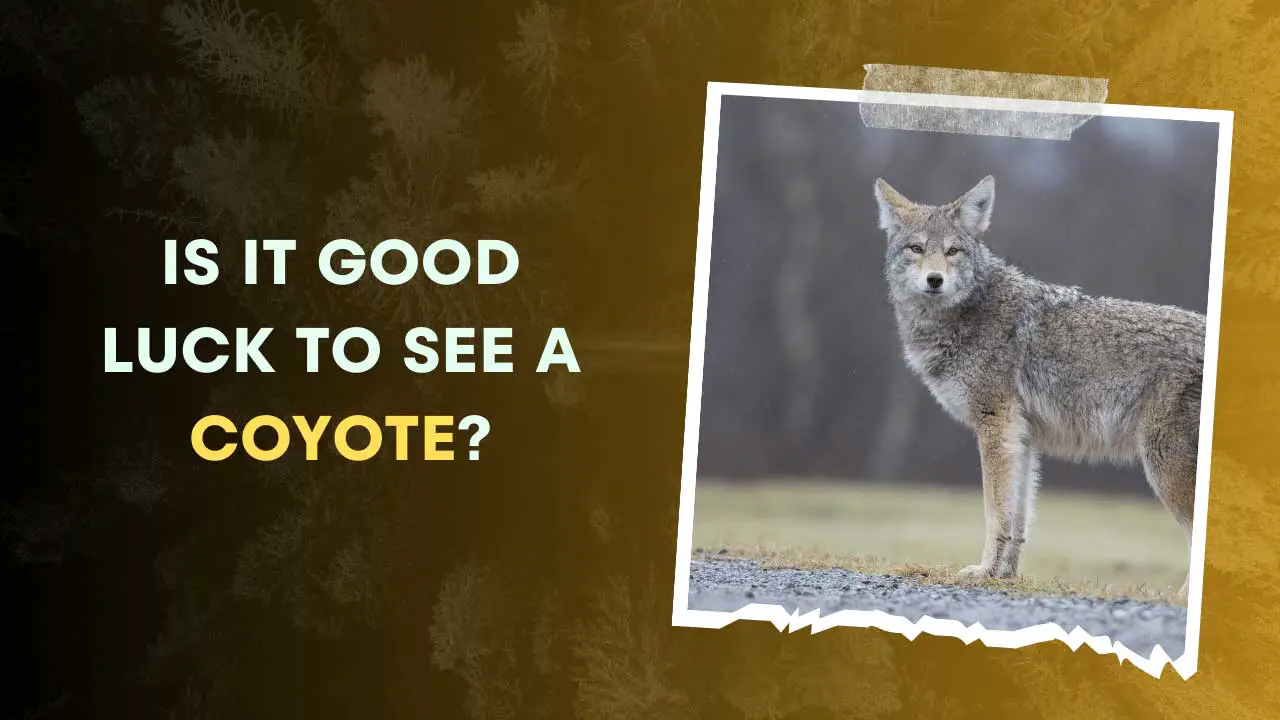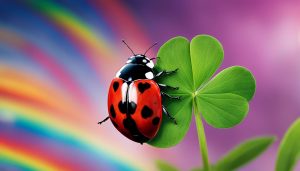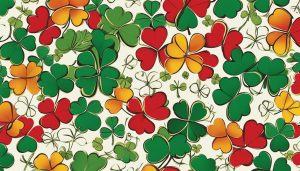Have you ever crossed paths with a coyote under the vast, starry sky and wondered if it held a hidden significance? Or perhaps spotted one in the wilderness while on an adventurous hiking trip, its eyes glinting mysteriously in the sunlight?
Today, we delve into an enchanting territory where folklore intertwines with modern perceptions, examining the intriguing question: Is it good luck to see a coyote?
In many cultures worldwide, animals are viewed as omens, their unexpected appearances in our lives often symbolizing luck, good or bad. And the coyote, a creature shrouded in a cloak of myths, legends, and tales, is no stranger to these beliefs.
So buckle up, intrepid readers, as we journey through ancient tribal legends, scientific insights, and personal experiences to decipher the enigmatic encounter with the coyote.
Will it be a stroke of luck or a mere coincidental meeting? Let’s find out together in this exhilarating exploration of the mystical world of coyotes!
Contents
- 1 The Prowler of the Wild: Unveiling the Coyote
- 2 Coyotes in Symbolism and Folklore:
- 3 Is it good luck to see a coyote?
- 4 Crossing Paths with the Coyote: A Stroke of Luck or a Simple Encounter?
- 5 Creating Your Serendipity: Beyond Animal Encounters
- 6 Meeting the Wild Eye-to-eye: Safety First in Coyote Encounters
- 7 Conclusion:
- 8 FAQs
- 8.1 I live in an urban area. Does seeing a coyote have the same significance here as in a rural or wild setting?
- 8.2 Is there a particular time of day when seeing a coyote is considered especially lucky?
- 8.3 What should I do if I encounter a coyote? Should I approach it for good luck?
- 8.4 Are there any specific actions to take following a coyote sighting to increase the chances of good luck?
- 8.5 Do different cultures have specific rituals or practices to follow after seeing a coyote?
The Prowler of the Wild: Unveiling the Coyote
The coyote, known scientifically as Canis latrans, or “barking dog,” is steeped in mystery and awe. A staple of North American landscapes, coyotes can be found in diverse habitats – from sprawling, desolate deserts to dense, urban cities.
Resilient and resourceful, these creatures have shown an uncanny ability to adapt and thrive in nearly all conditions, earning them a certain degree of admiration among ecologists.
Physically, coyotes resemble their canine relatives, with their pointed ears, slender muzzle, and bushy tail. They sport a coat of grayish-brown to yellowish-gray fur, allowing them to blend seamlessly into their surroundings.
Behaviorally, they’re renowned for their cunning and intelligence, often observed in their hunting strategies that employ solitary and pack methods, depending on the prey.
But there’s far more to these captivating creatures than meets the eye. They occupy a fascinating and multi-faceted role in popular culture and folklore.
Also read: Is It Good Luck To See A Fox?
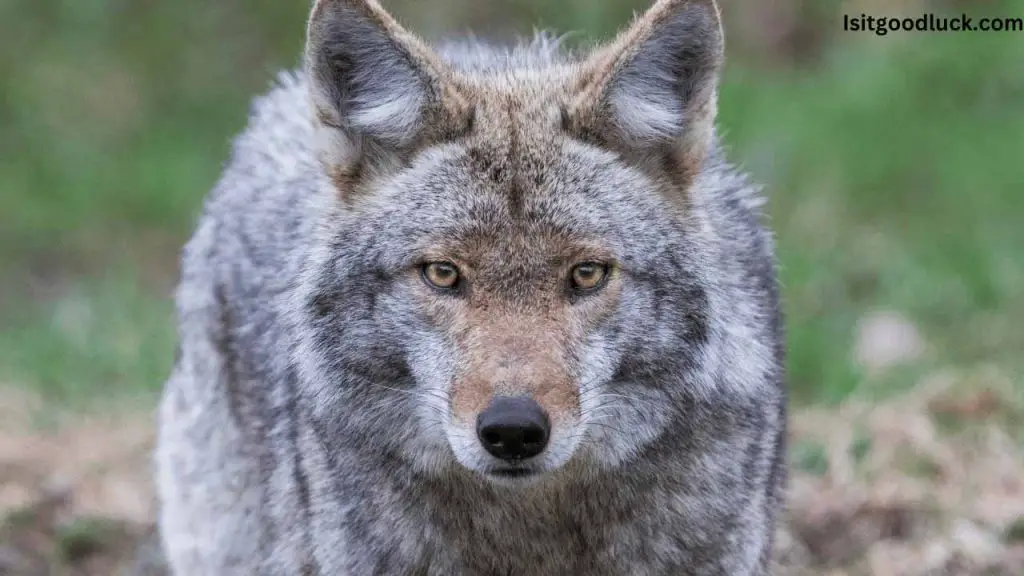
From ancient tales woven by Native Americans that depict the coyote as a wise trickster and cultural hero to modern depictions in cartoons like Wile E. Coyote in the ‘Road Runner’ show, these creatures have undeniably left their paw prints on our collective imaginations.
The coyote, thus, is not merely an animal; it’s a symbol, an archetype, and a narrative device used to communicate complex ideas and emotions.
As we explore the coyote and the luck it purportedly brings, let’s remember to appreciate these creatures’ real, tangible attributes and contributions to our ecosystems, alongside their more mystical associations.
Coyotes in Symbolism and Folklore:
Coyotes don’t just roam the wild or prowl our cities—they also roam through our stories and cultural imaginations, representing myriad meanings that change with each context they inhabit.
Arguably, the coyote’s spiritual and symbolic significance is nowhere more prominent than in Native American folklore. The coyote is often portrayed as a trickster, a shapeshifter dancing on the edge of moral codes, constantly challenging the status quo. Yet, this very trickery often brings wisdom and initiates change.
Many tribes, like the Navajo and Hopi, revere the coyote as a symbol of survival, adaptation, and transformation. Their stories teach us about life’s unpredictability, and the coyote, with its mischievous laughter echoing in the wild, seems to say, “Don’t take it all so seriously.”
Meanwhile, in Latin American beliefs, the coyote often embodies a dual nature. In Mexico, for instance, it’s seen as a wise guide who aids travelers in navigating their paths, particularly in crossing difficult terrains—literally and metaphorically. On the other hand, the coyote can also symbolize deception, embodying the darker aspects of human nature.
In our modern times, the coyote has evolved from a spiritual symbol to a creature of urban legends. Numerous tales circulate the internet, suggesting that spotting a coyote can bring prosperity or signal an impending disaster.
Yet, these stories often say more about our human need to find meaning and control in an unpredictable world than the coyotes themselves.
As we explore coyote symbolism, folklore, and mythology, remember that these stories reflect the kaleidoscopic nature of cultural interpretations. As a symbol, the coyote is as complex and multifaceted as the cultures that interpret it.
So whether it’s the trickster of Native American tales, the guide in Latin folklore, or the omen of modern urban legends, the coyote continues to weave its magic into our collective consciousness.
Also read: Is it Good Luck to See a Groundhog?
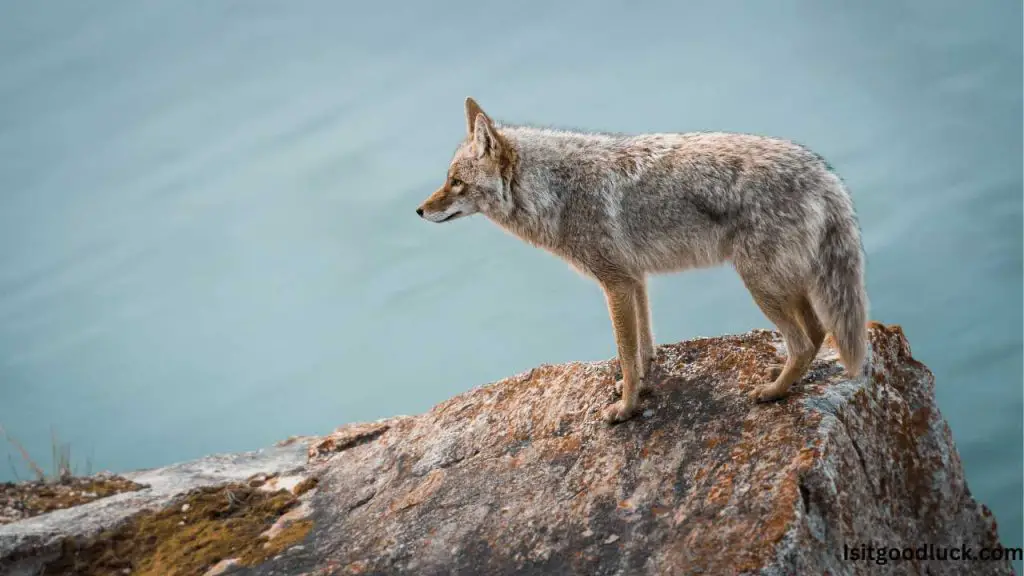
Is it good luck to see a coyote?
How often have you paused to wonder if crossing paths with a certain creature was a good omen or maybe a harbinger of misfortune? The notion of luck, like a coyote, can be elusive and shape-shifting, changing its guise depending on the culture interpreting it.
Across cultures and continents, animals have been viewed as powerful symbols; their appearances are often thought to bring fortune, good or bad.
In the West, a black cat crossing one’s path is often considered a sign of impending misfortune, while in Japan, the ‘maneki-neko’ or beckoning cat is a common talisman for good luck and prosperity.
Elephants in India, rabbits in European traditions, or cranes in China – each culture has its lucky charm encapsulated in these beautiful creatures.
But what about our enigmatic friend, the coyote? Does the sight of this adaptable canine bring luck, or is it a warning sign to tread cautiously?
It’s important to remember that attributing ‘luck’ to any event is a largely subjective and deeply personal interpretation. Just like beauty, luck often lies in the eye of the beholder.
In some Native American cultures, the appearance of a coyote can be viewed as a reminder not to take life too seriously, to maintain balance, or to adapt to changing circumstances – all of which can be seen as ‘good luck.’
On the other hand, some might see a coyote sighting as a cautionary sign, indicating that things are not what they seem.
Whether an encounter with a coyote – or any animal, for that matter – is considered lucky often depends more on personal beliefs, cultural context, and individual interpretation than on universal rules.
As we delve deeper into our exploration, let’s keep in mind this fluidity of the concept of luck, remaining open to the myriad interpretations it invites. After all, what makes such discussions wonderfully rich and intriguing?
Crossing Paths with the Coyote: A Stroke of Luck or a Simple Encounter?
Suppose you’re on an early morning walk, the world around you still basking in the soft glow of dawn. Suddenly, a rustle in the bushes catches your attention, and out steps a coyote.
It pauses, locking eyes with you for a fleeting moment before disappearing into the wilderness. An ordinary encounter or a sign of good fortune? This question is precisely what we’re here to delve into.
The concept of luck, particularly regarding animal encounters, is deeply ingrained in many cultures and belief systems. And yet, when it comes to the coyote, the answer isn’t as straightforward as finding a four-leaf clover or spotting a shooting star.
This is due, in part, to the coyote’s complex representation in various folklore and legends as both a trickster and a wise spirit.
For some, a coyote sighting can be interpreted as a positive sign. Within the tapestry of Native American folklore, the coyote, known for its cunning and adaptability, is often viewed as a symbol of resourcefulness and survival.
Seeing a coyote could symbolize the need to adapt to a situation or face a challenge with cunning, which could be seen as a piece of timely advice or good luck.
Conversely, due to the coyote’s reputation as a trickster, others may interpret a coyote sighting as a word of caution – a reminder to look beneath the surface and not be deceived by appearances. Is this a warning sign or merely a reminder of life’s complexities? That’s up to individual interpretation.
The idea of seeing a coyote as an omen of good luck largely depends on personal beliefs, cultural background, and individual interpretations of the situation.
So the next time you spot a coyote, remember – the mystery of the encounter makes it all the more enchanting. Whether it brings good luck or simply an interesting tale to tell, one thing’s for certain: it’s an encounter you won’t forget in a hurry!
Creating Your Serendipity: Beyond Animal Encounters
“Life is what you make it,” they say, and luck, dear reader, is no exception. As we journey through animal omens, it’s important to remember that while these encounters can offer us a moment of awe and introspection, they shouldn’t dictate our lives. The reality is, more often than not, we have the power to create our own luck.
This doesn’t mean we should disregard animal encounters’ symbolic significance entirely. On the contrary, these experiences can enrich our lives, broadening our perspectives and nurturing our connections with nature. But it’s also essential to balance and avoid over-relying on these symbols to shape our destiny.
Perhaps, the coyote’s real lesson is not about bringing us good or bad luck but about showing us the importance of adaptation, resourcefulness, and resilience — the traits that have enabled it to thrive in diverse environments. As the coyote does, we can also navigate life’s challenges with agility, learn from our mistakes, and carve out our paths. In other words, we can create our own ‘luck.’
So, next time you encounter a coyote or any other animal, take a moment to appreciate the experience for what it is — a beautiful interaction with a fellow creature sharing our planet.
Let the experience provoke thought and inspire you, but remember: You are the author of your own story. You are the creator of your luck. Whether the coyote symbolizes fortune or caution, let it not overshadow the most potent form of magic — your ability to shape your destiny!
Meeting the Wild Eye-to-eye: Safety First in Coyote Encounters
In our journey exploring the mystical and symbolic nuances of the coyote, let’s not forget that these captivating creatures are indeed part of the wild, with behaviors shaped by instincts and survival needs.
Though generally not a threat to humans, coyotes deserve respect and caution in any encounter. So, before we venture further into the coyote’s world, let’s take a moment to consider some important safety tips.
Firstly, never feed a coyote. As adaptable and smart creatures, they can quickly associate humans with food, leading to potential conflicts. If you encounter a coyote, admire its beauty from a distance, but avoid approaching or cornering it. Making loud noises or waving your arms can help to deter the coyote if it approaches too close.
Secondly, it’s always a good idea to supervise your pets, especially smaller ones, during dawn and dusk when coyotes are most active. Secure your trash cans, as they can often attract coyotes and other wildlife, and keep pet food indoors.
While we’re on safety, it’s also important to debunk some myths about the coyote’s aggressiveness. Despite portrayals in popular culture, coyotes are not typically dangerous to humans. Most prefer to avoid human interaction altogether. Conflicts often arise from misunderstanding and encroachment on the coyote’s habitats, not from inherent aggression.
A coyote sighting can be an exhilarating experience—a brush with the wild, a symbolic encounter, or a moment of awe. Still, remember to balance our fascination with the respect and caution these wild creatures deserve. In doing so, we can help maintain the harmony between our human world and the enchanting world of the coyote.
Conclusion:
As we end our explorative journey into the world of the coyote, we find ourselves enriched by tales of folklore, tales of luck, and perhaps even a little self-discovery. We’ve seen how different cultures perceive this enigmatic creature, from a trickster and a symbol of transformation to an omen of fortune or caution.
But the question remains – is it good luck to see a coyote? The answer, dear reader, is as elusive as the coyote itself. Like the creature that weaves in and out of the shadows, luck is subjective, influenced by personal beliefs, cultural backgrounds, and individual interpretations. What might be a sign of good fortune for one might be a word of caution for another.
One thing is for sure, though. Regardless of whether a coyote sighting brings good luck, such an encounter provides an opportunity—a moment to marvel at the rich tapestry of life, a reminder of our intrinsic connection to nature, and an invitation to appreciate the wisdom inherent in our wild counterparts.
As we venture forward, let’s keep the lessons of the coyote in our hearts – the trickster’s reminder to adapt and survive, to question and learn, and most importantly, to create our luck. And while we’re at it, remember to appreciate and respect the wildlife we share with this beautiful planet.
Whether you’ve seen a coyote or not or regard it as a harbinger of good fortune or simply a fellow earthling going about its life, we hope this exploration has added a new layer of understanding to your perception of these fascinating creatures.
And who knows? The next time you cross paths with a coyote, you might find a story waiting to be told, a moment of awe to be experienced, or a stroke of luck ready to unfold.
Thank you for journeying with us into the world of the coyote, the embodiment of wild resilience and an enduring symbol in our shared cultural narratives. Here’s to many more fascinating encounters, each weaving a unique story of its own, adding to the rich tapestry of our lives.
Also read other articles regarding animals good luck
FAQs
I live in an urban area. Does seeing a coyote have the same significance here as in a rural or wild setting?
The symbolic significance of seeing a coyote does not necessarily change based on the environment. However, in urban areas, coyote sightings are often associated more with the animals’ adaptability and resilience in navigating human-dominated landscapes. Whether this is a sign of good luck would largely depend on your beliefs and cultural context.
Is there a particular time of day when seeing a coyote is considered especially lucky?
There’s no universally agreed-upon time when seeing a coyote is considered lucky. The interpretation can vary greatly based on cultural beliefs and personal interpretations. Some might see the sighting at dawn as a symbol of new beginnings, while others might view an encounter at dusk as a sign of impending change. It’s all very subjective and personal.
What should I do if I encounter a coyote? Should I approach it for good luck?
It’s important to remember that coyotes are wild animals and should not be approached, even if you believe it might bring good luck. Observing the coyote safely, without trying to interact or interfere, is the best course of action. Respect for wildlife is crucial in all encounters.
Are there any specific actions to take following a coyote sighting to increase the chances of good luck?
There are no universally recognized actions to boost your luck following a coyote sighting. However, some people take the sighting as a prompt for self-reflection, meditation, or even a moment to acknowledge and respect the interconnectedness of all life forms.
Do different cultures have specific rituals or practices to follow after seeing a coyote?
Yes, different cultures may have specific traditions or practices linked to coyote sightings, largely due to the diverse symbolic significance of the coyote in various folklore and beliefs. For instance, in some Native American cultures, a coyote sighting might lead to introspection or storytelling related to the coyote’s role as a trickster or symbol of transformation. However, there are no universal rituals that apply to all cultures.

